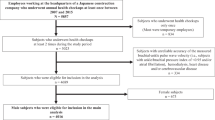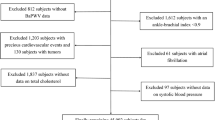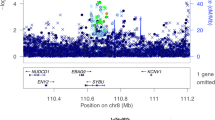Abstract
Elevated levels of circulating triglycerides and increased arterial stiffness are associated with cardiovascular disease. Numerous studies have reported an association between levels of circulating triglycerides and arterial stiffness. We used Mendelian randomization to test whether this association is causal. We investigated the association between circulating triglyceride levels, the apolipoprotein A-V (ApoA5) –1131T>C single nucleotide polymorphism and brachial–ankle pulse wave velocity (baPWV) by examining data from 4421 subjects aged 18–74 years who were recruited from the Chinese population. baPWV was significantly associated with the levels of circulating triglycerides after adjusting for age, sex, body mass index (BMI), systolic blood pressure, heart rate, waist-to-hip ratio, antihypertensive treatment and diabetes mellitus status. The −1131C allele was associated with a 5% (95% confidence interval 3–8%) increase in circulating triglycerides (adjusted for age, sex, BMI, waist-to-hip ratio, diabetes mellitus and antihypertensive treatment). Instrumental variable analysis showed that genetically elevated levels of circulating triglycerides were not associated with increased baPWV. These results do not support the hypothesis that levels of circulating triglycerides have a causal role in the development of arterial stiffness.
This is a preview of subscription content, access via your institution
Access options
Subscribe to this journal
Receive 12 digital issues and online access to articles
$119.00 per year
only $9.92 per issue
Buy this article
- Purchase on Springer Link
- Instant access to full article PDF
Prices may be subject to local taxes which are calculated during checkout


Similar content being viewed by others
References
Nordestgaard BG, Benn M, Schnohr P, Tybjaerg-Hansen A . Nonfasting triglycerides and risk of myocardial infarction, ischemic heart disease, and death in men and women. JAMA 2007; 298: 299–308.
Sarwar N, Danesh J, Eiriksdottir G, Sigurdsson G, Wareham N, Bingham S et al. Triglycerides and the risk of coronary heart disease: 10,158 incident cases among 262,525 participants in 29 Western prospective studies. Circulation 2007; 115: 450–458.
Miller M, Cannon CP, Murphy SA, Qin J, Ray KK, Braunwald E . Impact of triglyceride levels beyond low-density lipoprotein cholesterol after acute coronary syndrome in the PROVE IT-TIMI 22 trial. J Am Coll Cardiol 2008; 51: 724–730.
Laurent S, Cockcroft J, Van Bortel L, Boutouyrie P, Giannattasio C, Hayoz D et al. Expert consensus document on arterial stiffness: methodological issues and clinical applications. Eur Heart J 2006; 27: 2588–2605.
Vlachopoulos C, Aznaouridis K, Stefanadis C . Prediction of cardiovascular events and all-cause mortality with arterial stiffness: a systematic review and meta-analysis. J Am Coll Cardiol 2010; 55: 1318–1327.
Wang KL, Cheng HM, Sung SH, Chuang SY, Li CH, Spurgeon HA et al. Wave reflection and arterial stiffness in the prediction of 15-year all-cause and cardiovascular mortalities: a community-based study. Hypertension 2010; 55: 799–805.
Sarwar N, Sandhu MS, Ricketts SL, Butterworth AS, Di Angelantonio E, Boekholdt SM et al. Triglyceride-mediated pathways and coronary disease: collaborative analysis of 101 studies. Lancet 2010; 375: 1634–1639.
Tomiyama H, Yamashina A, Arai T, Hirose K, Koji Y, Chikamori T et al. Influences of age and gender on results of noninvasive brachial-ankle pulse wave velocity measurement–a survey of 12517 subjects. Atherosclerosis 2003; 166: 303–309.
Nakanishi N, Shiraishi T, Wada M . Brachial-ankle pulse wave velocity and metabolic syndrome in a Japanese population: the Minoh study. Hypertens Res 2005; 28: 125–131.
McEniery CM, Spratt M, Munnery M, Yarnell J, Lowe GD, Rumley A et al. An analysis of prospective risk factors for aortic stiffness in men: 20-year follow-up from the Caerphilly prospective study. Hypertension 2010; 56: 36–43.
Ho CT, Lin CC, Hsu HS, Liu CS, Davidson LE, Li TC et al. Arterial Stiffness is Strongly Associated with Insulin Resistance in Chinese -A Population-Based Study (Taichung Community Health Study, TCHS). J Atheroscler Thromb 2010; 18: 122–130.
Anderson SG, Sanders TA, Cruickshank JK . Plasma fatty acid composition as a predictor of arterial stiffness and mortality. Hypertension 2009; 53: 839–845.
Cecelja M, Chowienczyk P . Dissociation of aortic pulse wave velocity with risk factors for cardiovascular disease other than hypertension: a systematic review. Hypertension 2009; 54: 1328–1336.
Wang F, Ye P, Luo L, Xiao W, Qi L, Bian S et al. Association of serum lipids with arterial stiffness in a population-based study in Beijing. Eur J Clin Invest 2011; 41: 929–936.
Smith GD, Ebrahim S . Mendelian randomization: prospects, potentials, and limitations. Int J Epidemiol 2004; 33: 30–42.
Yamashina A, Tomiyama H, Takeda K, Tsuda H, Arai T, Hirose K et al. Validity, reproducibility, and clinical significance of noninvasive brachial-ankle pulse wave velocity measurement. Hypertens Res 2002; 25: 359–364.
Tsuchikura S, Shoji T, Kimoto E, Shinohara K, Hatsuda S, Koyama H et al. Brachial-ankle pulse wave velocity as an index of central arterial stiffness. J Atheroscler Thromb 2010; 17: 658–665.
Pennacchio LA, Olivier M, Hubacek JA, Cohen JC, Cox DR, Fruchart JC et al. An apolipoprotein influencing triglycerides in humans and mice revealed by comparative sequencing. Science 2001; 294: 169–173.
Martin S, Nicaud V, Humphries SE, Talmud PJ . Contribution of APOA5 gene variants to plasma triglyceride determination and to the response to both fat and glucose tolerance challenges. Biochim Biophys Acta 2003; 1637: 217–225.
Lai CQ, Demissie S, Cupples LA, Zhu Y, Adiconis X, Parnell LD et al. Influence of the APOA5 locus on plasma triglyceride, lipoprotein subclasses, and CVD risk in the Framingham Heart Study. J Lipid Res 2004; 45: 2096–2105.
Klos KL, Hamon S, Clark AG, Boerwinkle E, Liu K, Sing CF . APOA5 polymorphisms influence plasma triglycerides in young, healthy African Americans and whites of the CARDIA Study. J Lipid Res 2005; 46: 564–571.
Chandak GR, Ward KJ, Yajnik CS, Pandit AN, Bavdekar A, Joglekar CV et al. Triglyceride associated polymorphisms of the APOA5 gene have very different allele frequencies in Pune, India compared to Europeans. BMC Med Genet 2006; 7: 76.
Hallman DM, Srinivasan SR, Chen W, Boerwinkle E, Berenson GS . Longitudinal analysis of haplotypes and polymorphisms of the APOA5 and APOC3 genes associated with variation in serum triglyceride levels: the Bogalusa Heart Study. Metabolism 2006; 55: 1574–1581.
Martinelli N, Trabetti E, Bassi A, Girelli D, Friso S, Pizzolo F et al. The -1131 T>C and S19W APOA5 gene polymorphisms are associated with high levels of triglycerides and apolipoprotein C-III, but not with coronary artery disease: an angiographic study. Atherosclerosis 2007; 191: 409–417.
Jang Y, Paik JK, Hyun YJ, Chae JS, Kim JY, Choi JR et al. The apolipoprotein A5 -1131 T>C promoter polymorphism in Koreans: association with plasma APOA5 and serum triglyceride concentrations, LDL particle size and coronary artery disease. Clin Chim Acta 2009; 402: 83–87.
Baum L, Tomlinson B, Thomas GN . APOA5-1131T>C polymorphism is associated with triglyceride levels in Chinese men. Clin Genet 2003; 63: 377–379.
Jiang CQ, Liu B, Cheung BM, Lam TH, Lin JM, Li Jin Y et al. A single nucleotide polymorphism in APOA5 determines triglyceride levels in Hong Kong and Guangzhou Chinese. Eur J Hum Genet 2010; 18: 1255–1260.
Zhang HF, Zhu ZY, Yao WM, Xu F, Gong L, Wu ZJ et al. Prevalence and risk factors of atrial fibrillation in a rural area of Jiangsu Province. J Clin Cardiol (Chinese) 2010; 26: 773–775.
Kathiresan S, Melander O, Guiducci C, Surti A, Burtt NP, Rieder MJ et al. Six new loci associated with blood low-density lipoprotein cholesterol, high-density lipoprotein cholesterol or triglycerides in humans. Nat Genet 2008; 40: 189–197.
Olofsson SO . ApoA-V: the regulation of a regulator of plasma triglycerides. Arterioscler Thromb Vasc Biol 2005; 25: 1097–1099.
Zhao T, Zhao J . Association of the apolipoprotein A5 gene -1131 T>C polymorphism with fasting blood lipids: a meta-analysis in 37859 subjects. BMC Med Genet 2010; 11: 120.
The Reference Values for Arterial Stiffness' Collaboration. Determinants of pulse wave velocity in healthy people and in the presence of cardiovascular risk factors: ‘establishing normal and reference values’. Eur Heart J 2010; 31: 2338–2350.
Acknowledgements
The Gaoyou Study would not have been possible without the voluntary collaboration of the participants and the support of the local health bureau. This study was supported by grants from the National Key Technologies R&D Program of China during the 11th Five-Year Plan Period (2007BAI07A10) and the Jiangsu Province Science and Technology Support Program (BE2009613).
Author information
Authors and Affiliations
Corresponding author
Ethics declarations
Competing interests
The authors declare no conflict of interest.
Additional information
Supplementary Information accompanies the paper on the Journal of Human Hypertension website
Supplementary information
Rights and permissions
About this article
Cite this article
Yao, WM., Zhang, HF., Zhu, ZY. et al. Genetically elevated levels of circulating triglycerides and brachial–ankle pulse wave velocity in a Chinese population. J Hum Hypertens 27, 265–270 (2013). https://doi.org/10.1038/jhh.2012.23
Received:
Revised:
Accepted:
Published:
Issue Date:
DOI: https://doi.org/10.1038/jhh.2012.23
Keywords
This article is cited by
-
Comparison of arterial stiffness indices measured by pulse wave velocity and pulse wave analysis for predicting cardiovascular and all-cause mortality in a Chinese population
Hypertension Research (2024)
-
Age-differential association between serum uric acid and incident hypertension
Hypertension Research (2019)
-
Interaction between body mass index and serum uric acid in relation to blood pressure in community-dwelling Japanese men
Clinical Hypertension (2018)
-
Prevalence and associated factors of knee osteoarthritis in a rural Chinese adult population: an epidemiological survey
BMC Public Health (2015)



